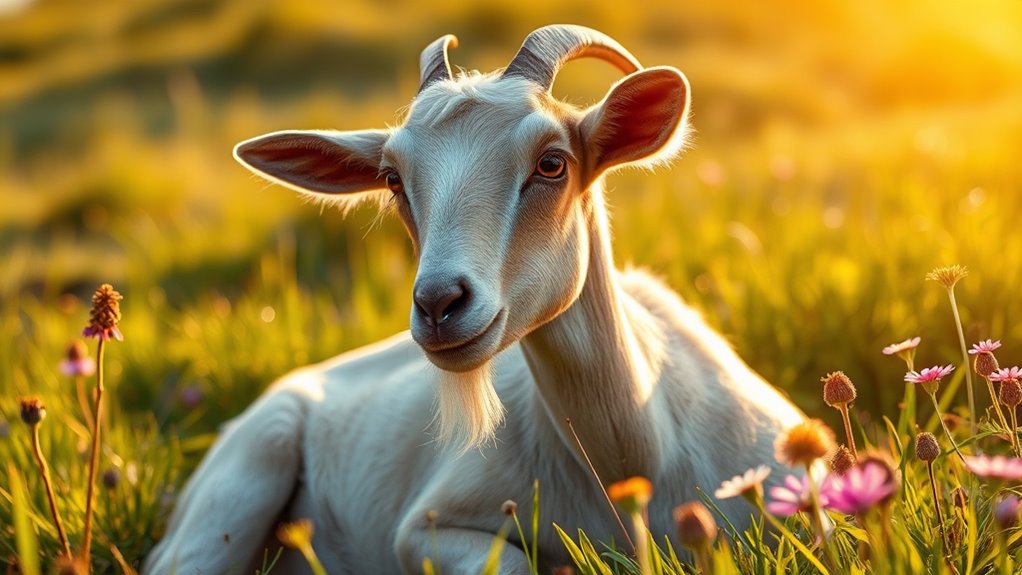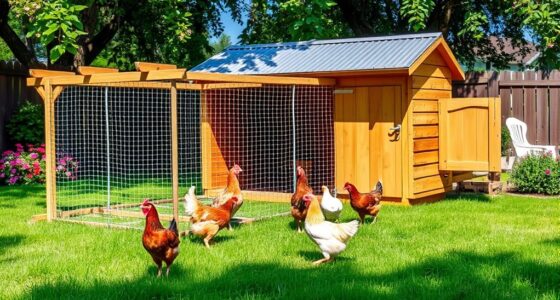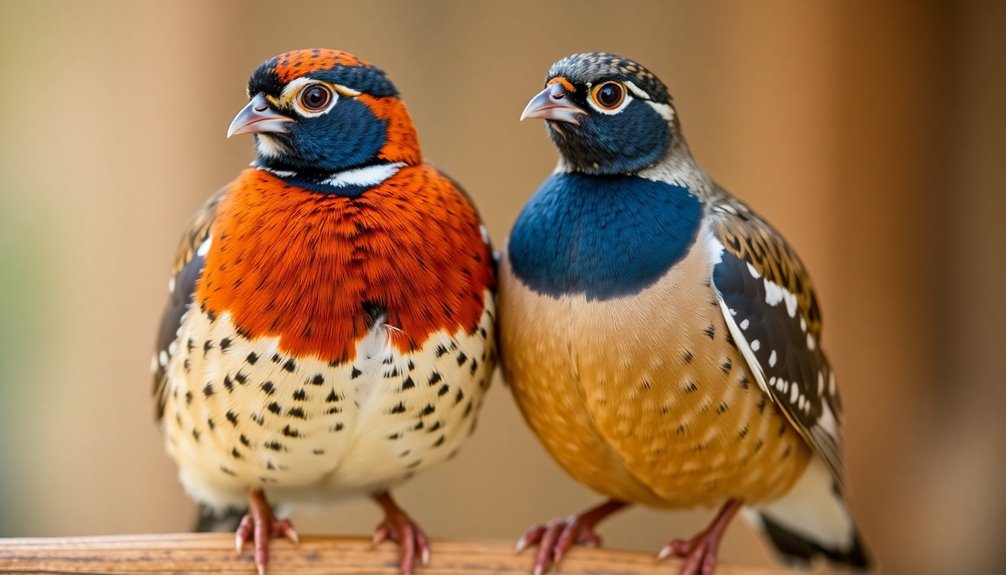To tell if your goat is expecting, watch for a failure to return to heat after her cycle, as well as an increased appetite. You might notice weight gain, bulging sides, and behavioral changes like seeking affection or nesting. Physical alterations such as udder development can also indicate pregnancy. Diagnostic methods like ultrasound can confirm pregnancy. If you suspect your doe might be pregnant, there's even more to learn about what to expect during this exciting time.
Key Takeaways
- Absence of heat cycles after 17-25 days is a strong indicator of pregnancy in goats.
- Increased appetite, especially in later stages, signals an energy requirement for the developing fetus.
- Noticeable weight gain and physical changes, like bulging sides and udder development, indicate progression of the pregnancy.
- Behavioral shifts, such as increased vocalization and nesting behaviors, can suggest impending kidding.
- Diagnostic methods like ultrasonography and hormone testing can confirm pregnancy as early as 30 days gestation.
Failure to Return to Heat
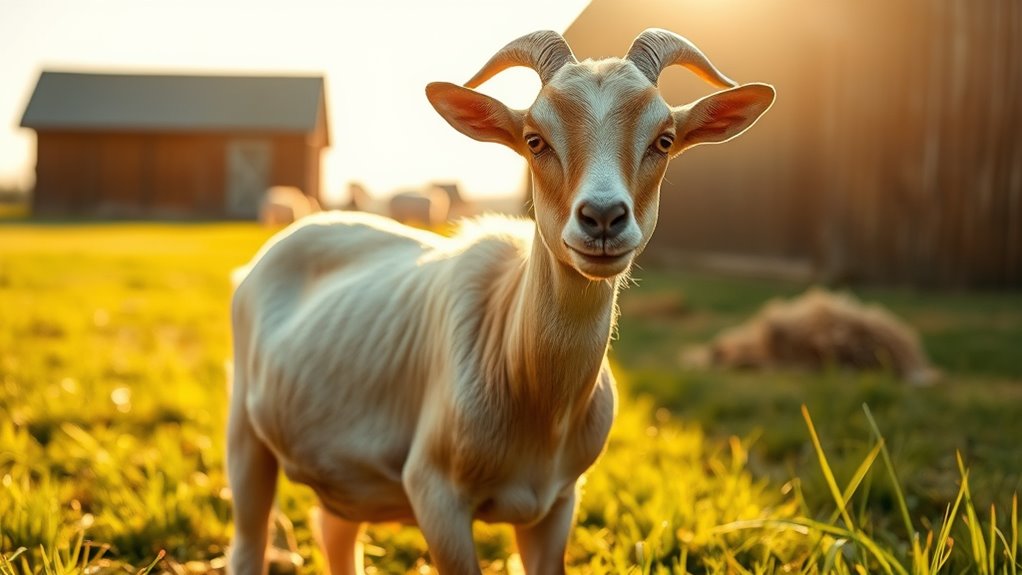
When a doe fails to return to heat after her expected cycle, it often signals pregnancy. Goats typically cycle every 17 to 25 days, so if your doe hasn't come back into heat, it's a strong indicator that she might be expecting.
Keep in mind that some does may show weak signs of estrus early in pregnancy, leading to false negatives. If an embryo is resorbed, she might return to heat as usual or up to six weeks later.
Additionally, at the end of the breeding season, does may not return to heat even if they're not pregnant. Monitoring her heat cycles closely will help you identify these changes more accurately and manage your breeding program effectively.
Increased Appetite
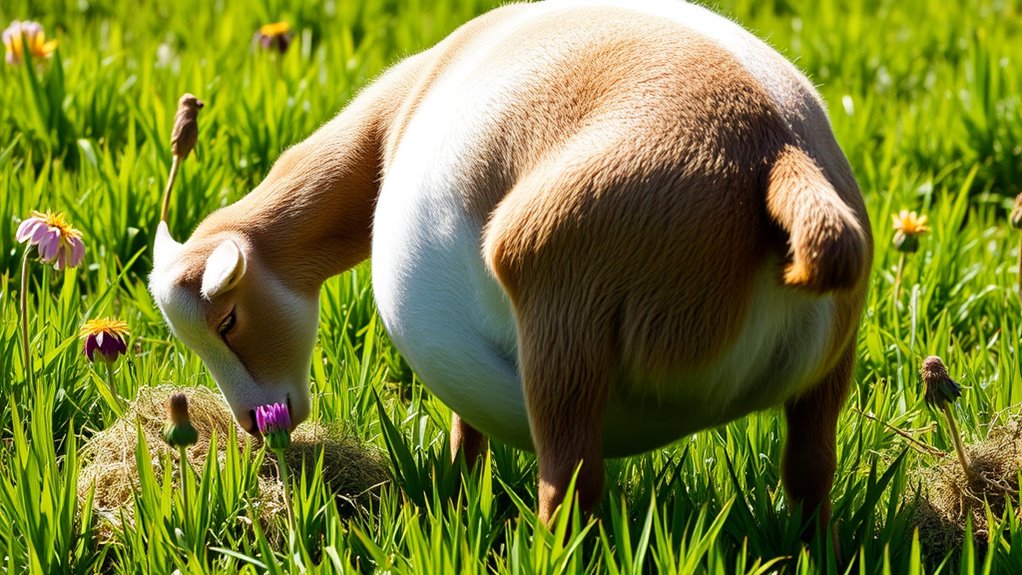
As your doe progresses through her pregnancy, you'll likely notice an increase in her appetite due to heightened energy requirements, especially in the later stages. This increased appetite is crucial as it supports her nutritional needs and those of her developing kids.
To meet these demands, consider incorporating more energy-dense foods like grains into her diet. Monitor her intake regularly, as a sudden decrease in appetite could indicate health issues like pregnancy toxemia or ketosis.
It's essential to provide smaller, more frequent meals to help manage her appetite and avoid digestive problems. By keeping track of her eating habits and consulting with a veterinarian if needed, you can ensure she stays healthy throughout her pregnancy.
Weight Gain and Physical Changes
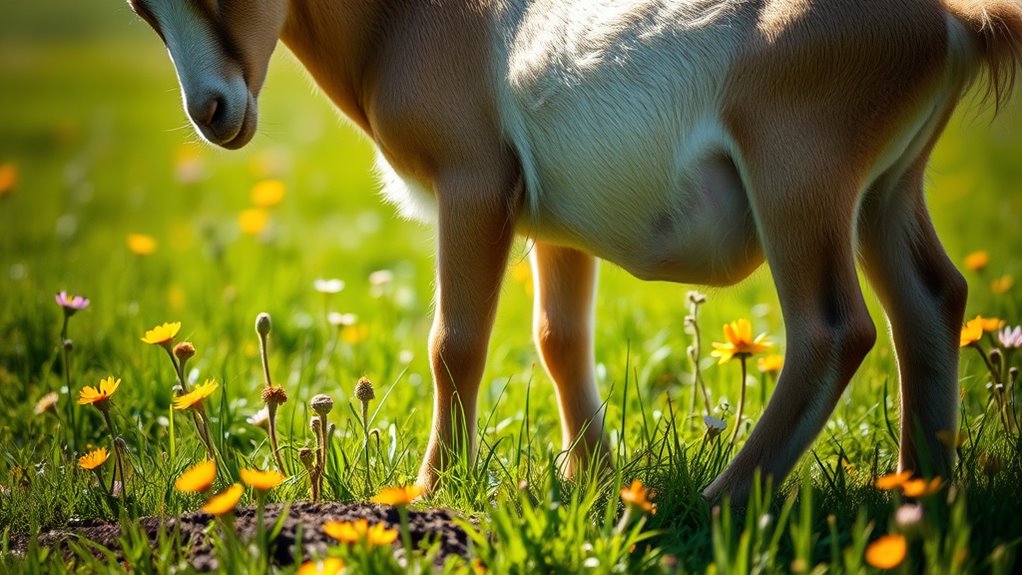
During pregnancy, does experience noticeable weight gain and physical changes that signal their condition.
You'll see weight gain patterns: initially, they gain about 2.7 grams per kilogram of body weight daily for the first 80 days, then it drops to 1.11 grams until 110 days, and finally slows to 0.02 grams by 140 days.
Look for bulging sides and developing udders, especially in seasoned does. You might even feel fetal movements by placing your hand on her lower side.
Additionally, teats may lengthen and grow thicker. Some does start gathering bedding as they prepare a birthing area, indicating that kidding time is approaching.
These signs are essential to monitor as your doe progresses through her pregnancy.
Behavioral Changes in Pregnant Does

Pregnant does often undergo a variety of behavioral changes that can signal their condition. You might notice some does becoming more standoffish as their pregnancy progresses, while others may seek extra affection and attention. Hormonal shifts can lead to these temporary changes in sociability.
As pregnancy advances, you may find your does avoiding strenuous activities, like jumping or climbing, preferring to rest instead. Mood swings can also occur; some does might appear irritable or less responsive.
Keep an eye out for signs of nesting behaviors as they prepare for birth, which include lying down frequently and vocalizing more. These behaviors are crucial indicators of their emotional and physical state during this time.
Diagnostic Methods for Confirming Pregnancy
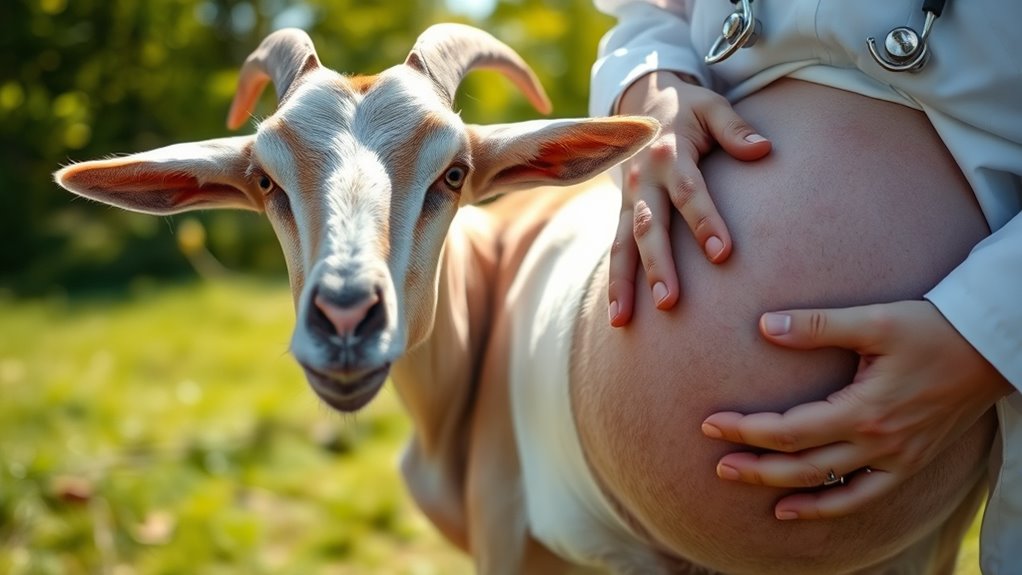
Confirming pregnancy in goats involves several diagnostic methods that veterinarians commonly employ. One of the most reliable techniques is ultrasonography, which can detect pregnancy as early as 30 days gestation.
You might also consider progesterone testing, where hormone levels in milk or serum can indicate pregnancy, although it doesn't confirm viability. The estrone sulfate test is another option, measuring hormone levels in plasma or urine that rise significantly during pregnancy.
Pregnancy-Specific Protein B (PSPB) testing is effective after 25-30 days and can help manage care in late gestation. While radiography offers 100% accuracy after day 70, its high cost and practicality issues make it less common.
Each method has its pros and cons, so consult your veterinarian to choose the best option.
Understanding the Gestation Period
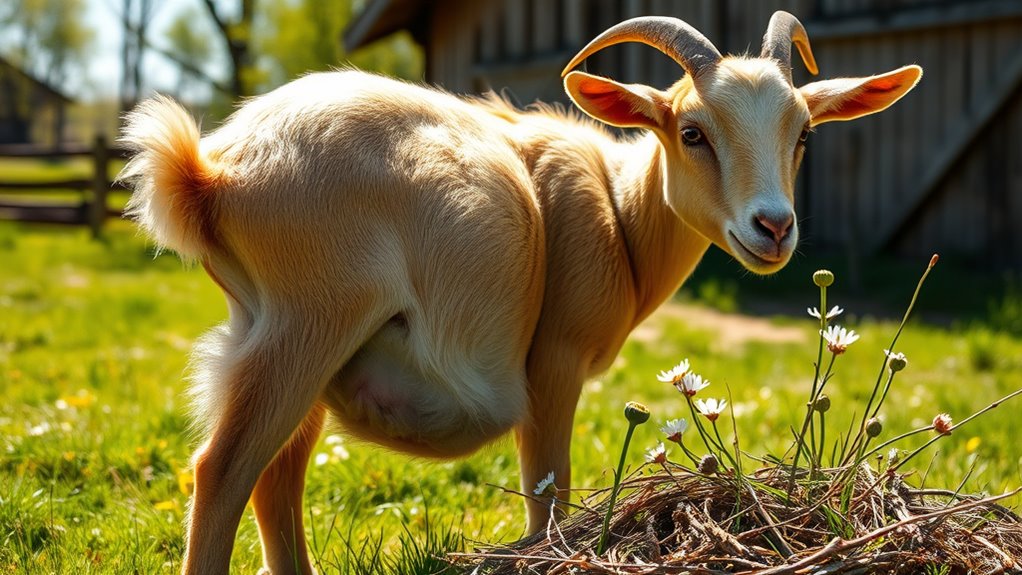
Understanding the gestation period is essential for any goat owner, as it typically lasts between 145 to 155 days, with an average of about 150 days.
Factors like breed size and timing of the estrus cycle can influence this duration. For instance, smaller breeds often have slightly shorter gestation periods.
Proper nutrition's crucial throughout the pregnancy, especially in the last month, to prevent pregnancy toxemia.
You'll want to keep detailed records of breeding and birth dates, which helps in predicting future gestation lengths and managing the health of your does effectively.
Regular health checks and monitoring their nutritional needs will ensure a successful pregnancy, making this period smoother for both you and your goat.
Signs of Impending Labor
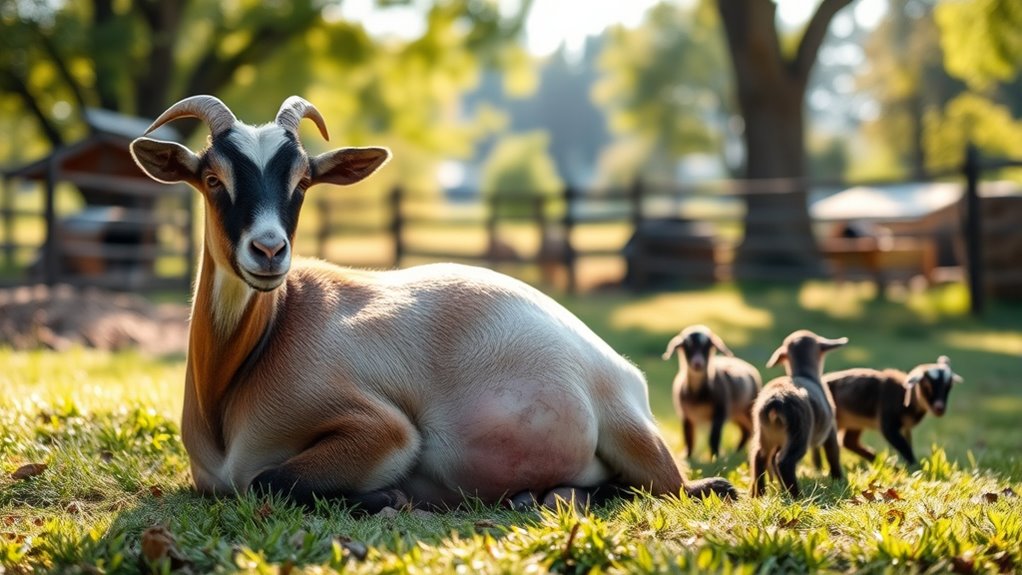
As the gestation period comes to a close, you'll start noticing specific signs that indicate your goat is nearing labor.
Look for physical changes like arching and stretching of the back, along with a sagging belly as the kids position themselves for birth. The udder will fill, and you may see the vulva swelling and a mucus discharge.
Behaviorally, your goat might become restless, refusing food, and seeking solitude. You may notice her pawing at the ground or vocalizing more than usual.
Pay attention to her posture; she may waddle, alternate between standing and lying down, and exhibit nesting behavior.
Tracking these signs helps you prepare for the exciting arrival of kids!
Labor and Kidding: What to Expect
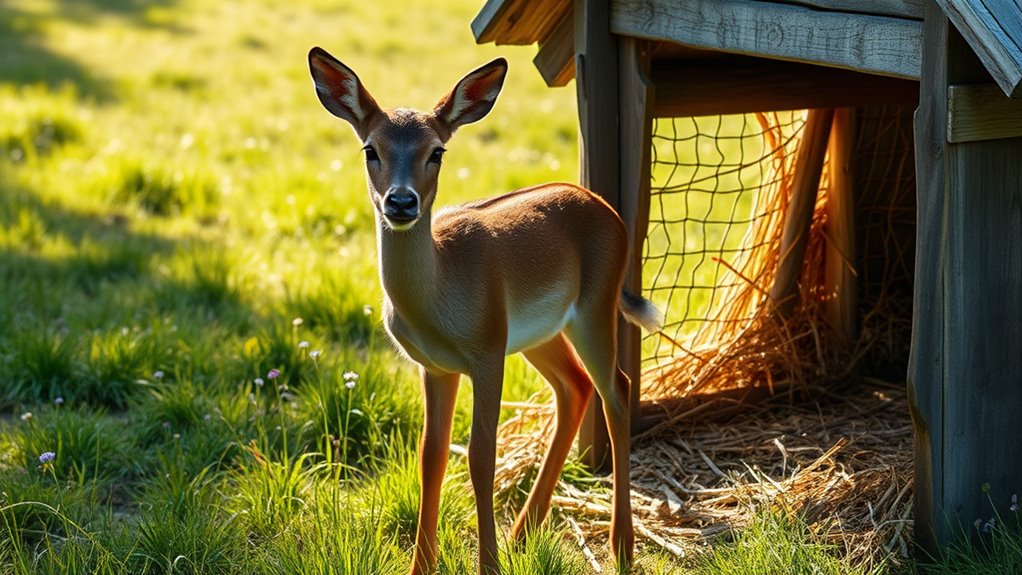
During labor, expect three distinct stages that lead to the arrival of your kids.
The first stage involves uterine contractions and can last up to 12 hours, though it's often shorter for experienced does.
The first stage of labor features uterine contractions, lasting up to 12 hours, but often shorter for experienced does.
Next comes hard labor, where the kids are delivered, typically within two hours. Keep an eye out for the water bag, which signals that delivery is imminent.
After the kids are born, the placenta should be expelled within a couple of hours.
Make sure to monitor your doe closely for any complications and provide a clean, quiet space for her.
After delivery, care for the umbilical cord with iodine and check that both the doe and kids are healthy.
Frequently Asked Questions
Can Goats Experience a False Pregnancy?
Yes, goats can experience a false pregnancy, also known as pseudopregnancy. This condition occurs when fluid accumulates in the uterus without a viable fetus.
You might notice signs like abdominal distention and udder enlargement, which can be misleading. Factors such as hormonal imbalances or environmental influences can contribute to this issue.
If you suspect a false pregnancy, it's essential to consult a vet for proper diagnosis and management to avoid complications.
How Can Stress Affect Goat Pregnancy Signs?
Stress can significantly affect your goat's pregnancy signs.
You'll notice physiological changes, like increased rectal temperature and respiration rate. Additionally, stress might lead to behavioral alterations, such as restlessness or decreased feed intake.
This can result in a shorter gestation length and impact the development of the offspring. By monitoring these signs and addressing stressors in their environment, you can help ensure a healthier pregnancy for your goat.
Are Certain Breeds More Likely to Show Early Signs?
Did you know that some goat breeds can show pregnancy signs as early as three weeks?
When it comes to certain breeds, yes, you'll find that some are more expressive than others. For instance, first-time does might display more noticeable signs compared to seasoned ones.
Additionally, your goat's health and nutrition can influence how clearly these early signs appear, so keep an eye on their overall well-being for the best insights.
What Should I Feed a Pregnant Doe?
When feeding a pregnant doe, focus on providing an energy-dense diet rich in high-quality forages, like legume hays.
Add grain supplements in late gestation to boost energy intake. Ensure her diet contains 14% to 16% protein from sources like alfalfa pellets.
Don't forget to offer mineral mixes and fresh water to meet her increased nutritional needs.
Regularly consult with a veterinarian for tailored dietary recommendations based on her condition and number of fetuses.
How Can I Help a Doe During Labor?
As you prepare for the arrival of new life, helping a doe during labor is crucial.
Keep a close eye on her, ensuring she's in a clean, quiet area with plenty of space. If she seems restless, monitor her for signs of distress.
Be ready to assist if she strains too long or needs help repositioning the kid.
Afterward, check on her health and provide food and water to aid recovery.
Conclusion
In conclusion, recognizing the signs of goat pregnancy can help you prepare for the arrival of new kids. From changes in appetite to behavioral shifts, being observant is key. Are you ready to embrace the joy and challenges that come with goat parenting? By understanding these signs and the gestation period, you'll be better equipped to support your pregnant doe and ensure a smooth labor and delivery process. Happy goat-raising!

